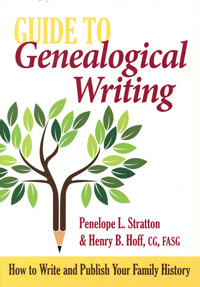 During the several years I worked as a publisher, I helped produce and print many genealogies, family histories, and memoirs. From that experience I developed strong opinions about when, how, and why a family history should be published. I believe strongly in the value of hard-bound, archive quality paper book over e-books, though there is a place for the e-book. The printed family history should, must, contain stories. Not only pictures tell a thousand words, but any image; including certificates, deeds, hand-written letters, charts, etc.; helps bring to life the lives of our ancestors, and helps create an historical perspective words alone cannot yield.
During the several years I worked as a publisher, I helped produce and print many genealogies, family histories, and memoirs. From that experience I developed strong opinions about when, how, and why a family history should be published. I believe strongly in the value of hard-bound, archive quality paper book over e-books, though there is a place for the e-book. The printed family history should, must, contain stories. Not only pictures tell a thousand words, but any image; including certificates, deeds, hand-written letters, charts, etc.; helps bring to life the lives of our ancestors, and helps create an historical perspective words alone cannot yield.
No matter my personal opinions on what a finished book should look like, what makes a published family history a success, a book worth reading, depends mostly upon the work and decisions made by its creator and/or author(s). There are skills to learn, standards to follow, and creative decisions to make, long before a book goes to print. Many of these tools and standards change over time. So, if you are thinking about, or have even started the process of, publishing a family history, then I have a recommendation for you.
The Guide to Genealogical Writing: How to Write and Publish Your Family History is an easy-to-read, easy-to-follow, up-to-date book on family history publishing. Authors Penelope L. Stratton and Henry B. Hoff cover the process of writing and publishing from beginning to end. Learn what you need to know before you ever start writing. In these pages you will learn proper genealogical styles and formatting, learn to make tough decision about what to include and what to leave out, decide which images to include, learn about design and layout, and much more.
I personally appreciate the authors’ inclusion of enough details to help you complete much of the work on your own, while providing pro and cons to seeking professional services when appropriate. Knowing enough to know your own limitations, even if your only limitation is time, is an important skill to master if you ever want to finish your project.
One unique feature to this guide is coverage not just for writing a book but also for writing with the intent to publish in registers, journals, and/or magazines. There is even a chapter dedicated to writing “short or informal family histories.”
A significant bonus to the family history writer, is the 24-page, detailed Genealogical Manual of Styles included after the appendices. The guide cover “all your questions about how to present genealogical information: how to treat alternate spellings of names, when and how to insert lineage lines, how to include adopted children and stepchildren, and more.”
Information about ordering your own copy and a short bio on the authors can be found below the contents.
Contents
Preface
Using This Book
Part I: Preparing
1: Getting Started
Part II: Writing
2: Writing in Genealogical Style
3: Making a Stylesheet
4: Writing When Questions Remain
5: Adding Citations
6: Incorporating Narrative
Part III: Getting Ready to Publish
7: Reviewing and Revising Your Draft
8: Selecting Illustrations
9: Considering Design and Layout
10: Indexing
11: Tying Up Final Details
Part IV: Writing Articles and Other Types of Family Histories
12: Writing for the Register and Other Journals
13: Writing for American Ancestors and Other Magazines
14: Writing Short or Informal Family Histories
Appendixes
A: Using Microsoft Word for Genealogical Writing
B: Sample Questionnaire for Relatives
C: Resources for Writing and Publishing
Genealogical Manual of Style
Illustration Credits
Index
About the Authors
About NEHGS and Newbury Street Press
Copies of Guide to Genealogical Writing: How to Write and Publish Your Family History are available from Family Roots Publishing; just click the book title to order.
About the Authors
“Penelope L. Stratton is Publishing Director of the New England Historic Genealogical Society. She oversees the publication of books and periodicals, including books published under the Newbury Street Press imprint and books for the Great Migration Study Project. Prior to joining the NEGHS staff in 2006, Penny worked in both educational and trade book publishing. She has contributed article sot American Ancestors magazine and has given numerous presentations on various aspects of writing and publishing family histories.”
“Henry B. Hoff, CG, FASG, a member of the NEGHS staff since 1996, is editor of The New England Historical and Genealogical Register. Previously he served as editor or consulting editor of The New York Genealogical and Biographical Record. Henry is the author of more than 200 genealogical articles in genealogical periodicals, and is the co-author, editor, or co-editor of several books, including two previous writing guides published by NEGHS.”